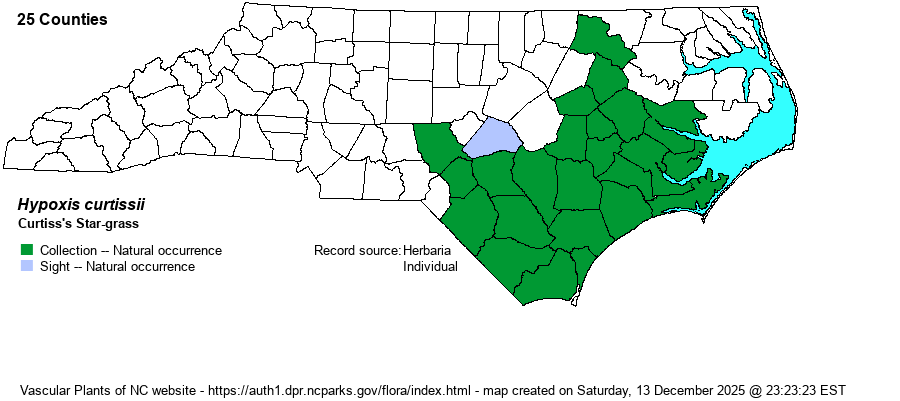| Author | Rose | |
| Distribution | Throughout the southern and central Coastal Plain, though scarce in the Sandhills proper. Ranges north to Halifax County, and likely absent from the northeastern 1/4 of the Coastal Plain.
This is a mainly Coastal Plain species (as are most of the state's Hypoxis species), ranging from southeastern VA to southern FL and west to southeastern TX. | |
| Abundance | Fairly common to common in most of its Coastal Plain range, probably rare to uncommon along the northern portions. | |
| Habitat | This species favors blackwater (and less frequently brownwater) stream edges and swamps, as well as wet places in bottomland forests. Though there are six species in the genus in NC, this is the only one of swamp forests and other wet wooded habitats. | |
| Phenology | Blooms from March to June, and fruits from May to July. | |
| Identification | This and H. hirsuta have the same general appearance: a cluster of linear leaves (to about 6-12 inches long), and a stalk up to about 4-8 inches tall with a few to several bright yellow to golden-yellow star-shaped flowers of 6 tepals at the top. Our other star-grasses usually produce only a single flower per plant. This species has smooth leaves. The common and widespread H. hirsuta usually has pubescent leaves and can be further separated from H. curtissii by having an ovary that is fairly broad and deltate in shape and is densely pubescent, as opposed to a cylindrical ovary that has only a few hairs (in H. curtissii). Normally, the two can be easily separated by habitat, as H. hirsuta does not grow in swamps (though it can occur in bottomlands), especially blackwater ones; and by the normally wider leaves (up to 1/2-inch wide) that are almost always smooth in H. curtissii. Normally a biologist does not encounter many herbaceous species in bloom in a swamp forest or on slightly raised islands within a swamp, and thus the bright yellow flowers of this species can be quite showy and one of the few spots of color on the forest floor. | |
| Taxonomic Comments | This species was simply listed as a variety of H. hirsuta in RAB (1968), and named as H. hirsuta var. leptocarpa. Most references have now long considered this as a good species.
| |
| Other Common Name(s) | Swamp Star-grass, Common Yellow Star-grass (a poor name). Note that the species is named for A.H. Curtiss, not Curtis. | |
| State Rank | S3S4 [S4] | |
| Global Rank | G4? | |
| State Status | | |
| US Status | | |
| USACE-agcp | FACW link |
| USACE-emp | FACW link |

